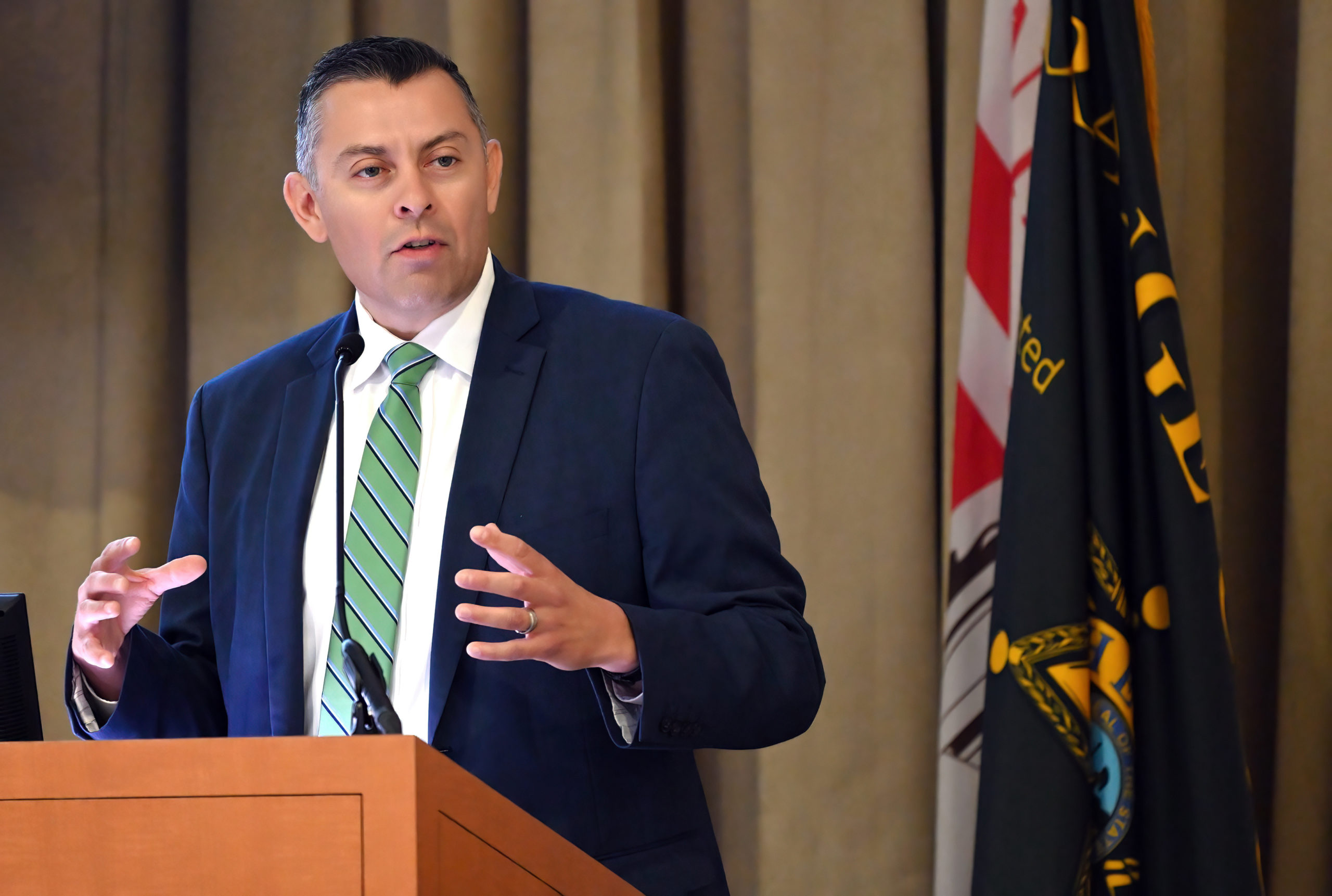Alberto Martinez is the director of the Orange County Intelligence Assessment Center (OCIAC), also often known as a fusion center. Formed in 2007, OCIAC was created to meet the need for information sharing among federal, state and local law enforcement agencies and other public safety disciplines to fight terror and crime.
OCIAC works with partners throughout public safety awareness such as SafeOC and the Department of Homeland Security’s See Something Say Something campaign to heighten public awareness and participation in helping thwart terrorism, criminal activity and improve public safety.

Alberto Martinez, Director, Orange County Intelligence Assessment Center, moderates the School Safety Summit at the OCSD Regional Training Academy in Tustin.
Photo by Steven Georges/Behind the Badge
In the wake of the September 11 terror attacks came the realization that vital clues that might have stopped the attacks had been missed, in part due to a lack of intelligence sharing. The National Network of Fusion Centers, each independently operated, was created to allow collaboration and ensure unfettered exchange of information and data. OCIAC grew out of the Orange County Sheriff’s Department Terrorism Early Warning Group, which operated from 2001 to 2007.
The Orange County center is one of six in California and operates under the auspices of the Orange County Sheriff’s Department, however it’s designated as a regional asset with staff representing Orange County municipal law enforcement and fire agencies including state and federal partners. There are currently about 80 fusion centers located in all 50 states, Washington D.C., Puerto Rico, Guam, and the U.S. Virgin Islands. Since 2006, the U.S. Department of Homeland Security (DHS), FBI, and other federal, state and local agencies have deployed personnel to work within fusion centers.
With the 21st anniversary of the September 11 terrorist attacks looming, Behind the Badge recently spoke with Martinez about the changing nature of intelligence and terrorism.
BTB: Generally, September 11 is equated with terrorism in the United States. However, the WTC attack was a complex, coordinated effort from a foreign terrorist group. Since then, the nature of terrorism has changed. What do you see as the the main threats of terrorism today?
Martinez: The threats have evolved. I think our threat environment is more dynamic nationally. It’s not just international terrorism as you saw 21 years ago, but a variety of terrorism. Foreign terrorist organizations continue and will be a concern for us in the homeland. Now you’ve got domestic violent extremists here in the nation. We have transnational organized crime. A big one that we see is cybercrime. The evolution is just the use of technology by nation-state actors, activists, criminal syndicates, counter intelligence and threats to our critical infrastructure. So I think there’s more of a variety of programs that are facing the homeland. Twenty-one years after the September 11 attacks, I think there are individuals who are inspired to conduct mass violence. These homegrown extremists are intending to mobilize for violence. A lot of it is happening online. The challenge is to identify those individuals who have a grievance against specific policy or an ideology. That’s always a challenge for us at this moment.
BTB: How great is the possibility of something as massive as the September 11 attacks occurring again?
Martinez: I think it’s probably changed. I think Al Qaeda and ISIS continue to be a threat for us. But I think what we’re seeing is a lot more small-arms attacks, individuals who are quickly mobilizing to violence. Unlike Al Qaeda, ISIS, and some of these foreign terrorist organizations, who have been patient in their planning, we see a lot of individuals who are conducting attacks very quickly. We call it flash to bang. There’s just a small window where someone tends to take their grievance from a thought to an action. I think that’s the challenge that we’re seeing in recent events occurring across the nation.
BTB: Can you talk about the importance and role of fusion centers?
Martinez: We’ve done a great job with our information sharing apparatus. We learned our lessons very quickly on who was not sharing information on September 12th, the day after. I think 21 years later we continue to show and teach everyone that information sharing is very critical. Someone may have a piece of the puzzle and that’s very important for us. That’s how the evolution of fusion centers came about, it was to be that conduit and broker for information sharing between the federal partners and state and local governments.
BTB: Do you think that the improvement of information sharing has been responsible for large-scale, well-coordinated, long-term plots being thwarted?
Martinez: Yes. I think as a recipient and a consumer of information from our federal partners, I think I may have seen personally a lot more information sharing across the board. Is there room for improvement? Absolutely. But overall, having embedded FBI and DHS and other federal partners in our fusion center is a success that shows the partnership and the effort that’s been made to ensure that we’re all seeing information, both laterally and horizontally. (In the past) it was a one-way street. It was the federal government and the military that had the information. But now it’s very nice to see that our federal partners are really relying on us to identify, collect, and analyze that information and share it with the appropriate investigative agencies.
BTB: Have there been any actual or imminent attacks or threats that were thwarted by OCIAC?
Martinez: Last year, assistant executive director for the FBI, Jill Sanborn, noted how OCIAC identified a racially motivated extremist group online that was intending to conduct attacks. Since then, that information spawned out to other investigations across the nation. We don’t have a crystal ball, you don’t know for sure those individuals were going to conduct attacks, but yes, we are very confident that OCIAC and regional partners have possibly thwarted incidents of mass violence. And that’s the purpose of us, to analyze that information. Because one piece of information one city may have might be related to another incident across the region or even the nation, and OCIAC is best positioned to receive that information and identify those specific threats.
BTB: It is said mass shooters almost always leave clues before they act. How is it that these warning signs so often go by without being addressed?
Martinez: I think that’s a question where it’s an opportunity for engagement, not just on the law enforcement side. By the time that information reaches law enforcement, it might be too late. What other opportunities are available to interdict that type of behavior? I think (the recent) school conference (the OC Sheriff’s School Safety Summit) was a good opportunity, where you had school administrators, law enforcement, major health professionals, clinical psychologists, practitioners, and university managers. We are all part of the process. The end goal was, if you see something, let’s say something. That’s very important for us.
BTB: Do you find it difficult navigating between gathering information on legitimate threats and violating a person’s civil rights?
Martinez: In this country, we have the blessing of our Constitution, our Bill of Rights, Freedom of Speech and First Amendment protected activity. I think sometimes in law enforcement we’re challenged with information. So, vetting that information is very important for us. But adhering to those specific goals, our focus is the behavior. That’s where the concern is, is this behavior indicative of criminal or terrorist activity? Is this individual going to mobilize? So that’s what our focus is on. The vetting process is key for us, while always respecting and prioritizing the practice of our civil liberties.
BTB: How do you decide between someone who is a “keyboard warrior” just venting, and a person who may be ready to act?
Martinez: By reviewing the totality of circumstances. I think if there’s a capability or intent or just additional information that requires us to identify that, hey, someone may be mobilized, that’s when we take action. But it is a challenge online. There’s so much rhetoric. There’s so much information, misinformation occurring online. And nowadays, it’s very easy to follow and be influenced or be encouraged and incited just from online websites.
BTB: Do you have any final thoughts?
Martinez: In closing, I think the reason OCIAC has flourished in Orange County is the strong support of all the municipal agencies here. Orange County has always been progressive in information sharing and I think that’s a result of the strong support that we received from our local public safety officials here in Orange County. I just feel like we are very fortunate. Behind the scenes there are amazing men and women here at OCIAC who are working around the clock to protect the communities and support our local partners, and we do our best to ensure nothing happens here.
 Behind the Badge
Behind the Badge



